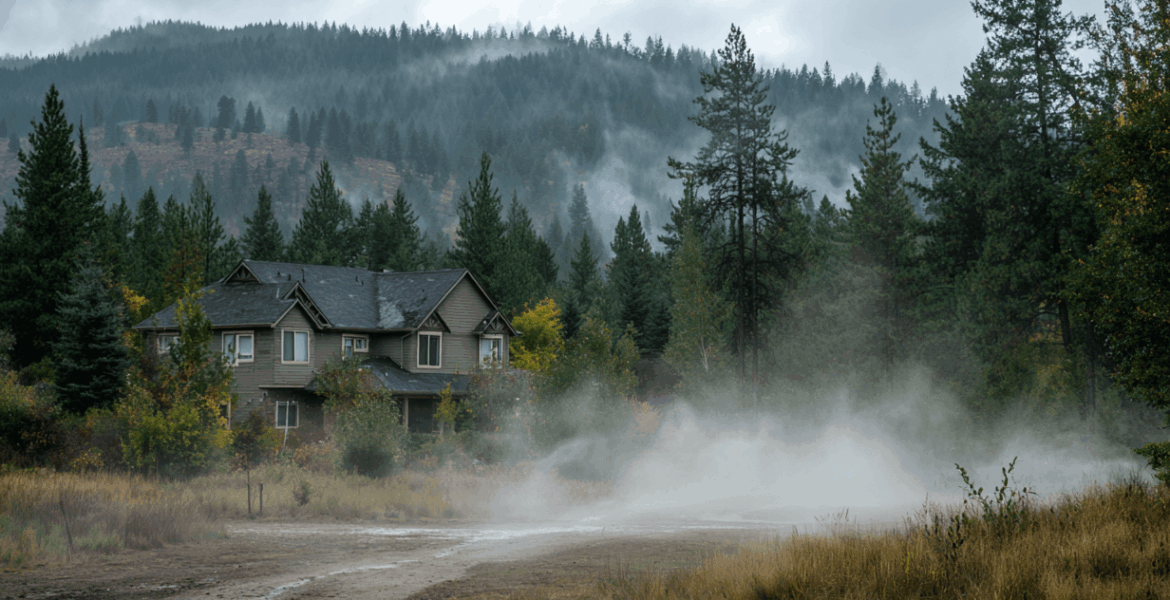Protecting a campground from wildfire isn’t just about having a hose and hoping for the best. It means building a layered strategy, starting with: risk assessment, working through mitigation, engineered protection systems, staff training, monitoring and a clear response plan. At SPIEDR, we’ve worked with landowners, fire professionals, and communities, to build infrastructure and systems at the wildland/structure interface. Those same principles apply to campgrounds nestled in forested, remote, or semi-remote, terrain. Use this guide as your practical roadmap to readiness.
Understand and assess your campsite’s wildfire risk
Begin by evaluating how fire‐vulnerable your property really is. Look at the vegetation: is it dense forest or scattered trees, open meadow or continuous shrubs? How much exposure to wind and slope does your site have? How dry do fuels become in peak fire season? What have past wildfire seasons looked like? Also consider logistics: access routes, water sources (tanks, hydrants, ponds), evacuation options—and of course the assets you’re trying to protect (cabins, RV pads, lodge, utilities, guest zones). At SPIEDR we emphasize that mitigation starts with a solid wildfire risk assessment. When you know what you’re up against, you can plan with clarity.
Create defensible spaces and manage fuels
Once you’ve mapped your risk, move to reduce it. For example: establish a cleared buffer around critical assets like the lodge, guest cabins or RV sites. Thin trees and shrubs so fire cannot easily jump from ground fuels into the canopy. Remove dead leaves, branches and woody debris that act as kindling. Set up fuel-breaks or fire-guards to interrupt large expanses of continuous vegetation. Ensure safe transitional zones between campsites, structures and the forest’s edge. Ultimately, fuel-management remains the foundational strategy in wildland interface fire protection—a methodology SPIEDR applies regularly in our consulting work.
Deploy wildfire-protection systems
Vegetation work is essential, but it’s only part of the story. The next step is to integrate engineered systems ready for rapid deployment when fire danger spikes. For many campgrounds, this means:
- Mobile sprinkler systems or trailer-mounted units (ideal if you have multiple buildings or remote zones).
- Mounted wildfire structure protection sprinklers (great if you have expensive permanent structures like cabins or rec/mess halls).
- Reliable water access: checked and ready hoses, hydrants, tanks and pumps.
- Equipment placed so it’s unobstructed and accessible (avoid hoses trapped behind RVs or brush).
- Defined setup procedures triggered by high-risk conditions (fire-danger rating thresholds, wind shifts, dry-fuel accumulation).
If your site spans remote terrain or has multiple structures, SPIEDR’s mobile wildfire-protection units provide a turnkey solution tailored for exactly those scenarios.
Train your team and establish protocols
A great plan is nothing without people who know their roles. Educate your staff about wildfire alerts, evacuation signals and shutdown procedures. Ensure guests receive a briefing at check-in, signage is clear, evacuation maps are available, and check-in staff can point out safe zones. Conduct drills before fire season and refresh during peak periods. Prepare a “go-bag” of essential gear: communication devices, portable pumps, protective clothing, hoses and key switch-off tools. Every person on-site should understand their role, act quickly, and form part of a coordinated response.
Monitor conditions and remain alert
Fire behaviour can change in minutes. Staying ahead means keeping tabs on local fire danger ratings and forecasts issued by regional authorities. On-site, assess how dry the fuels are, check equipment readiness, clear access routes and monitor guest activities such as campfires, charcoal BBQs or smoking zones. Enforce safe practices and fuel-storage protocols. By maintaining an early-warning mindset, you’ll be ready to activate your preparedness long before flames arrive.
Response and evacuation planning
Even with the best preparation, you must be ready to act. Define evacuation routes, designate safe assembly points and craft guest-movement protocols. Assign specific staff roles: who closes gates, contacts fire services, escorts guests, activates equipment. Maintain clear communication channels between staff, guests and emergency services. If fire danger becomes immediate, trigger your protection systems, relocate guests safely, shut down utilities if needed and liaise with crews. A well-practised emergency script ensures you can respond decisively when every minute matters.
FAQ
Q: How far should vegetation be cleared around campground structures?
A: A helpful guideline is around 9 metres (30 ft) of clearance around structures, although steeper slopes or high-risk zones may require greater distances.
Q: Are regular campfires allowed during high-risk periods?
A: When fire danger is elevated, it is wise to restrict or suspend open campfires. Consider propane or pellet grills instead, enforce fire-ring maintenance and supervision. Of course, refer to your local fire ban regulations.
Q: What role does a trailer-mounted sprinkler or mobile fire-unit play at a campground?
A: If your campground includes remote buildings or multiple structures, a mobile unit gives you rapid-deployment fire-suppression capability—with pumps, hoses and sprinklers staged and ready.
Q: How often should staff training or drills be conducted?
A: At least once annually (before fire season), with a mid-season refresher if you’re in a high-risk zone or have staffing changes.
Q: What should we do if fire danger becomes extreme?
A: Be prepared to suspend operations, pre-evacuate if necessary and activate protection systems in advance. Your readiness plan should include clear triggers for when to pause operations or evacuate entirely.


